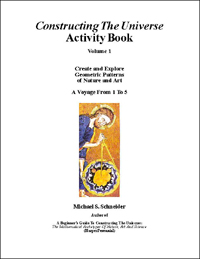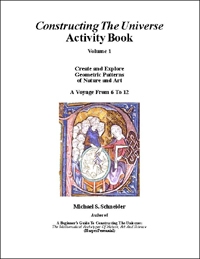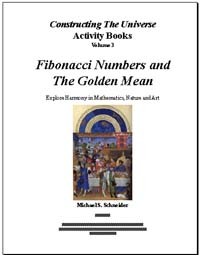The Geometer's Creation Myth
The creation myths of many traditions describe the universe as the work of a Divine Architect who uses "sacred geometry" to unfold the dimensions of a beautiful cosmos, wisely designing every aspect of it, and governing by just proportions evidenced in the geometric shapes and processes of nature. Various societies through history, seeking to live in accord with the cosmic harmony, modeled their realms on the Divine Architect's "sacred geometry" plan, creating cosmologically oriented societies which mirrored on Earth the celestial twelve-part zodiac. Everything, including their myths, laws, rituals, architecture, language, literature, music, furniture, coins, weights and measures, was integrated in a unified harmonious scheme. Enjoy an illustrated journey through this ancient worldview, and a timeless perspective on our own place in the cosmic creating process.
The Geometry of Fruits & Vegetables
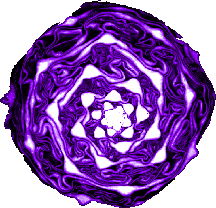
Simple plants express profound wisdom through the patterns of their architecture. Participants will learn to see the familiar world differently by observing how a simple number pattern, known as the Fibonacci Series, sits at the heart of plant design and the marvelous patterns of life and growth. Learn from plant architecture the secrets of balance, rhythm, proportion and unity in diversity, the fractal interconnection of parts with each other and the whole.
Pythagorean Arithmetic: Figurate Numbers
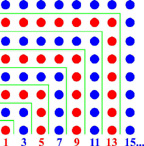 The
sum of sequential odd numbers produces a square (and square number
of pebbles).
The
sum of sequential odd numbers produces a square (and square number
of pebbles).
Traditional mathematics education in ancient Babylon, Egypt, Greece and Rome used limestone pebbles in visual patterns to reveal the fundamental relationships among numbers. (Thus we have the relation of the words "calcium" and "calculate".) This workshop will show you how to appreciate this time-honored, intelligently simple and effective system for exploring the properties of numbers and shapes.
The Tetraktys
The Tetraktys is a triangle of 10 (= 1+2+3+4) points. Along with the Pentagram star it was a central symbol of the Pythagorean school (c500 BCE) whose interests included the scientific and spiritual order of the cosmos, and ourselves as its fractal microcosm. Learn how the simplicity of the Tetraktys masks profound wisdom about nature, the harmonious concords of the musical scale, and our own inner structure.
Magic Squares
A "magic square" is an arrangement of numbers so that all columns, rows and diagonals add to the same sum. More than just mere curiosities, they show us the harmony inherent among numbers, and thus harmony among principles at work in the world. This view was held throughout antiquity where magic squares appear. In ancient China they were used in traditional feng-shui to determine the proportions of sacred architecture. They have alchemical associations with metals and planets. Learn the history and philosophy of magic squares, and especially how to create them.
Knotted-Rope Geometry
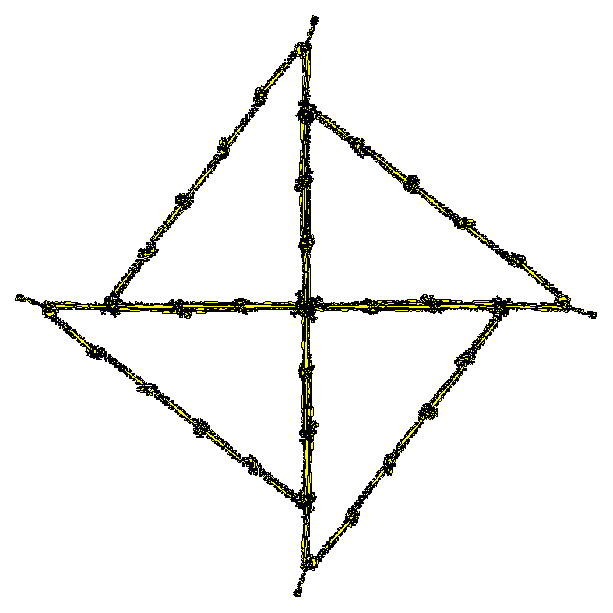
Before the divider compass was used, geometric construction was done using a loop of string, cord or rope with twelve equally spaced knots, or markers thrust into the weave. This is the method of the "rope stretchers" (Greek harpedonaptae) described in literature and depicted in art, including Egypt and India. The benefit of a twelve-knotted loop is that it easily becomes a three-four-five sided right-triangle, or a three-by-three square, an equilateral triangle of side four, a regular hexagon of side two, and in combinations form other useful shapes including regular pentagons and decagons, without having to actually know how to "do" the construction with traditional tools. With this knowledge students will be able to replicate the traditional temple-foundation construction which orients the building to the horizon at the solstices and equinoxes.
The Five Platonic Solids
There are a variety of innovative ways for actively exploring three-dimensional space, but only five ways that space can be divided equally in all directions from a center. This class investigates thesw fundamental structures of space, including their history, characteristics, along with hands-on activities with their familiar and unusual constructions, their harmonious number patterns, appearances in nature and technology, and symbolism.
The Cosmological Circle


The "Cosmological Circle" refers to a geometric diagram which appears in worldwide designs of temples, kivas, churches, mandalas and other expressions of sacred arts, crafts and architecture. Its mathematical secret is that it makes visible the harmony of all the numbers 1 through 12 and so represents a harmonious sacred microcosm. We'll see how its "squared-circle" core insures that such temples are properly oriented to the solstices and equinoxes, and symbolizes that the site occurs at the meeting of Heaven and Earth.
Music of the Spheres
It has been said that architecture is music made visible, and music is number made audible. The ancient sages understood the Divine Architect's universe, and ourselves, as an unfolding musical scale, a spiritual ladder between "Heaven and Earth" by which we have arrived here and may reascend. Their metaphor was the division of a vibrating string into four harmonious musical intervals, the concords (literally "hearts together") from which the traditional 5-, 7- and 12-note scales are built. This class will explore this tradition of a musical universe, using a vibrating string monochord to discover the four harmonious concords, and how this harmony has been applied to the designs of sacred architecture from Greek temples to Gothic cathedrals. Learn how to attune yourself by chanting the beautiful proportions of sacred arts, crafts and architecture.
 The Spiral Path
of Conflict Resolution
The Spiral Path
of Conflict Resolution
The spiral is the most widespread shape in nature. When left alone, energy tends to move and grow as spirals. From seashells and whirlpools to atoms, embryos and galaxies, it is also a worldwide symbol of self-transformation as Biblical whirlwinds, Native migrations and the Yellowbrick Road to Oz. This slide-lecture includes scores of images of natural spirals. The spiral's lessons include the secrets of the whirlpool's "calm eye" and about finding our own calm center, the calm "I" of the storm during times of personal turbulence, motion and growth. Its mathematical secret is that the logarithmic spiral reveals the path of harmonious resolution resulting from the conflict represented by rational and irrational number relationships.
For more about spirals, click here.
The Solar System Mandala
When the elliptical orbits of all nine planets are rounded to circles ("mean orbits"), their intervals coincide (with 99.9% accuracy) to geometric constructions, great mandalas of our solar system. In this construction, the orbits of the planets to Saturn conform to an octagonal pattern, while beyond it reveals a triangular symmetry. Bring a compass, straightedge, blank paper and colored pencils to learn step-by-step how to construct this geometric scheme of celestial harmony. Based on the work of John Martineau.
Ancient Metrology: Straightening Out Sacred Measure
There is great confusion today concerning metrology, the history of measurement systems around the world. Beyond the child's tales of the "foot" deriving from some king's foot, measurement was actually part of a sacred system of knowledge established in prehistory and based on timeless truths seen in the harmony of the cosmos. Standards of measure were everywhere framed upon never-changing principles of number, in particular, the interplay of natural tension between ten and twelve, and the dimensions of the turning Earth. Except for the survival of the English system in the U.S., most other traditional systems of measurement worldwide have succumbed to the "easy" and modern, but inferior "metric" system, which uses only ten, is divorced from nature and the human scale, and requires its users to conform to the measuring tools themselves, not to the nature of the objects measured, as was traditionally done. This class is an introduction to the brilliant workings of this unified system of measure, and how different cultures derived their individual measures of length from it. Based on the work of John Michell and John Neal.
